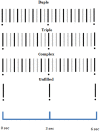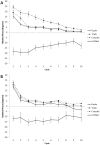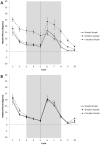Tapping to a slow tempo in the presence of simple and complex meters reveals experience-specific biases for processing music
- PMID: 25075514
- PMCID: PMC4116158
- DOI: 10.1371/journal.pone.0102962
Tapping to a slow tempo in the presence of simple and complex meters reveals experience-specific biases for processing music
Abstract
Musical meters vary considerably across cultures, yet relatively little is known about how culture-specific experience influences metrical processing. In Experiment 1, we compared American and Indian listeners' synchronous tapping to slow sequences. Inter-tone intervals contained silence or to-be-ignored rhythms that were designed to induce a simple meter (familiar to Americans and Indians) or a complex meter (familiar only to Indians). A subset of trials contained an abrupt switch from one rhythm to another to assess the disruptive effects of contradicting the initially implied meter. In the unfilled condition, both groups tapped earlier than the target and showed large tap-tone asynchronies (measured in relative phase). When inter-tone intervals were filled with simple-meter rhythms, American listeners tapped later than targets, but their asynchronies were smaller and declined more rapidly. Likewise, asynchronies rose sharply following a switch away from simple-meter but not from complex-meter rhythm. By contrast, Indian listeners performed similarly across all rhythm types, with asynchronies rapidly declining over the course of complex- and simple-meter trials. For these listeners, a switch from either simple or complex meter increased asynchronies. Experiment 2 tested American listeners but doubled the duration of the synchronization phase prior to (and after) the switch. Here, compared with simple meters, complex-meter rhythms elicited larger asynchronies that declined at a slower rate, however, asynchronies increased after the switch for all conditions. Our results provide evidence that ease of meter processing depends to a great extent on the amount of experience with specific meters.
Conflict of interest statement
Figures













References
-
- Hannon EE, Trainor LJ (2007) Music acquisition: effects of enculturation and formal training on development. Trends Cogn Sci 11: 466–472. - PubMed
-
- Flege JE, Bohn OS, Jang S (1997) Effects of experience on non-native speakers' production and perception of English vowels. J Phonetics 25: 437–470.
-
- McClelland JL, Fiez JA, McCandliss BD (2002) Teaching the/r/-/l/discrimination to Japanese adults: Behavioral and neural aspects. Physiol Behav 77: 657–662. - PubMed
-
- Meissner CA, Brigham JC (2001) Thirty years of investigating the own racebias in memory for faces - A meta-analytic review. Psychol Public Pol L 7: 3–35.
Publication types
MeSH terms
LinkOut - more resources
Full Text Sources
Other Literature Sources
Miscellaneous

